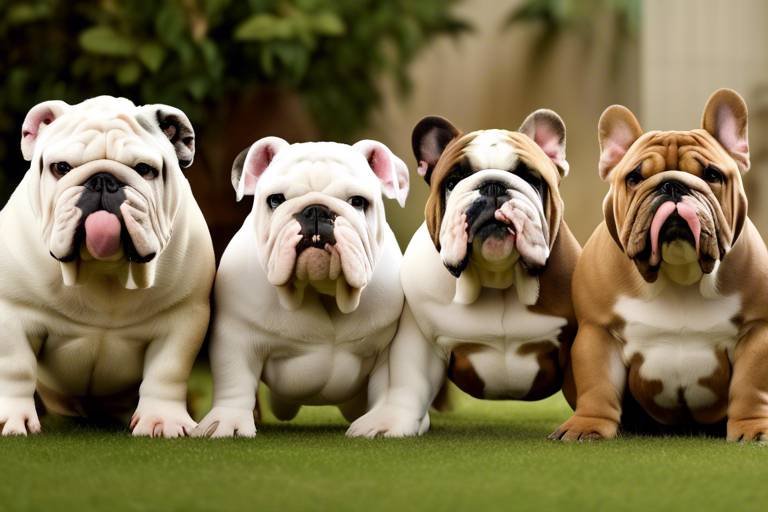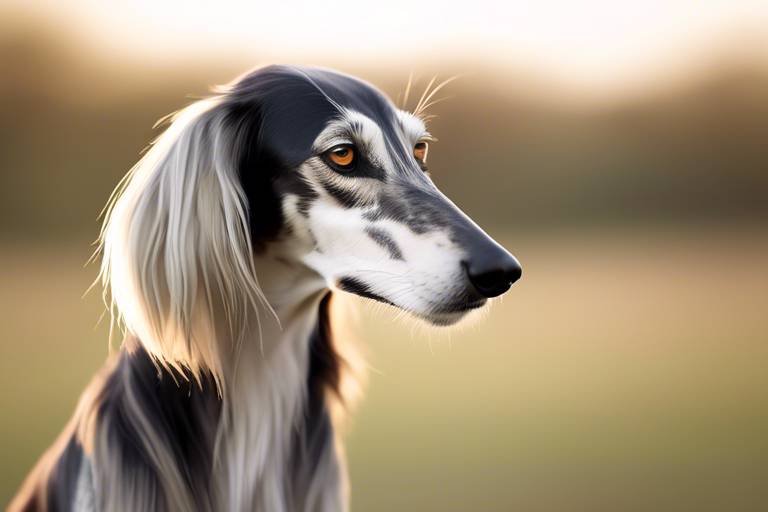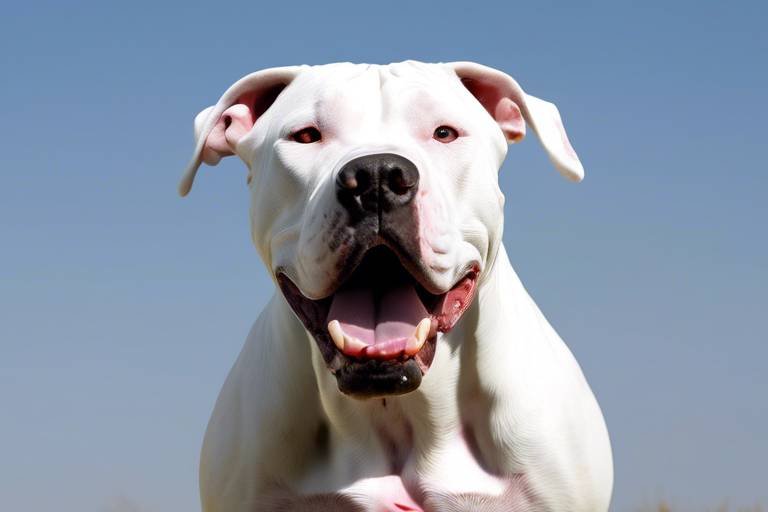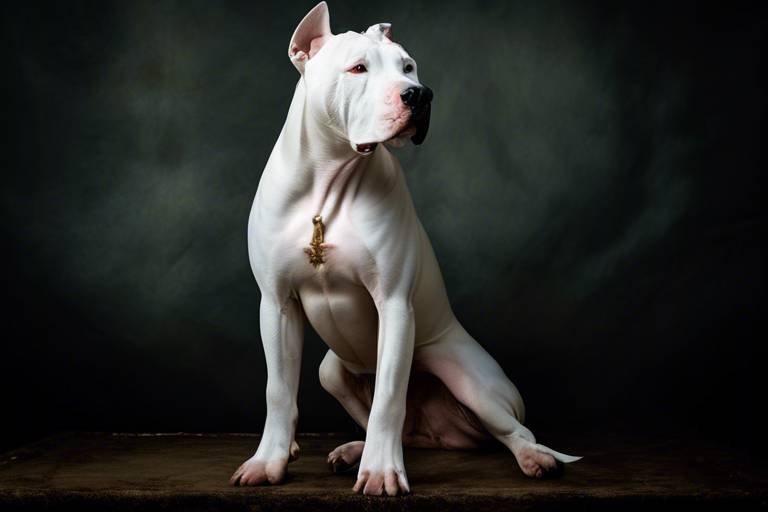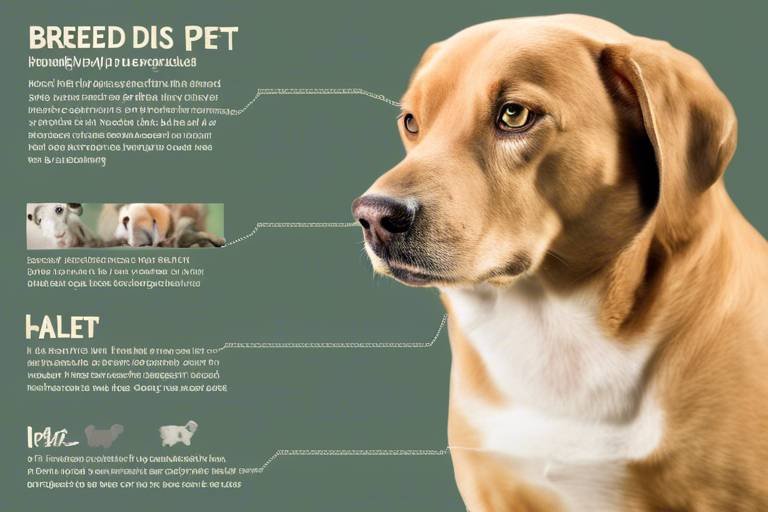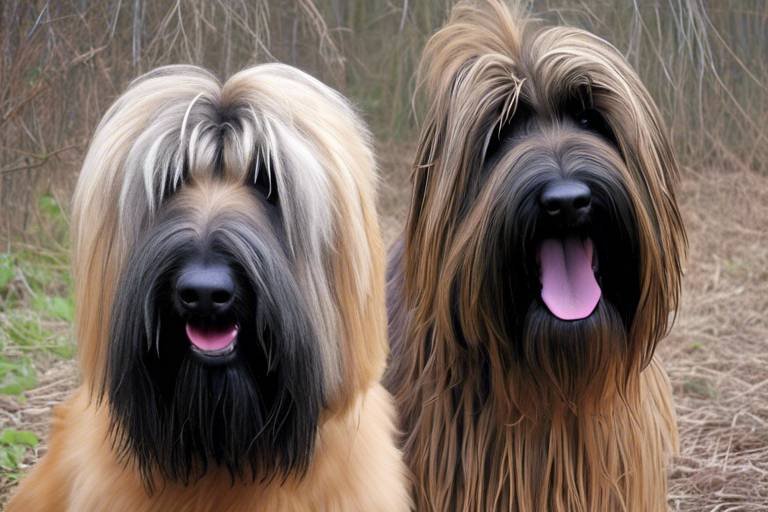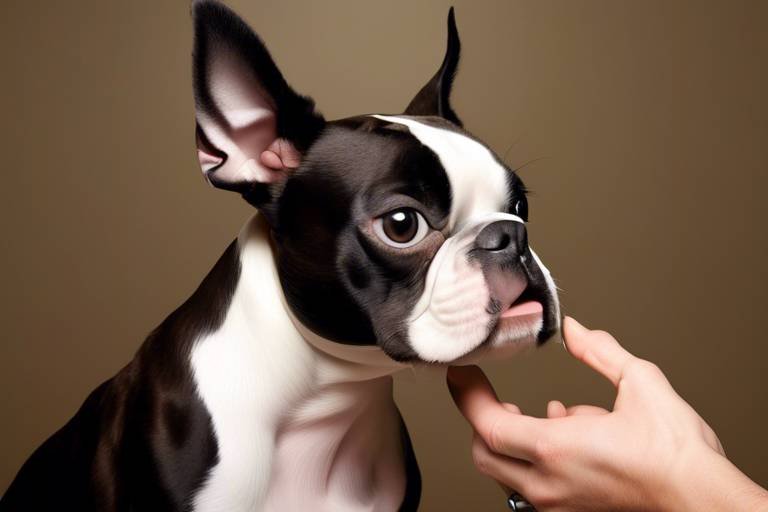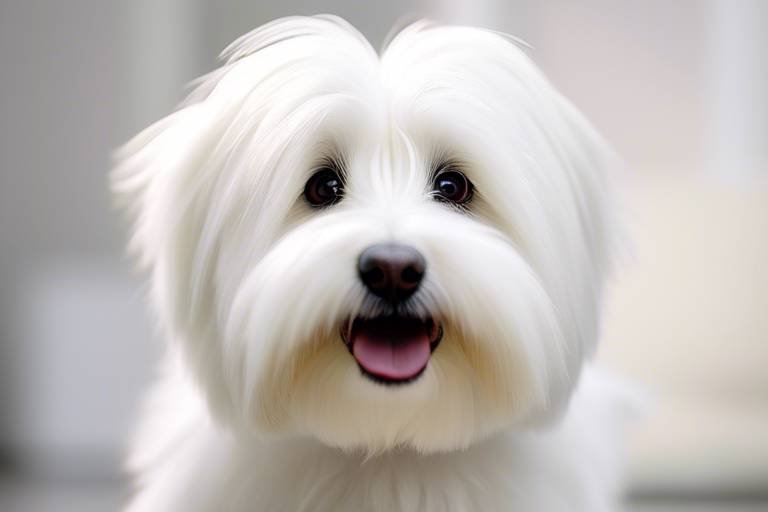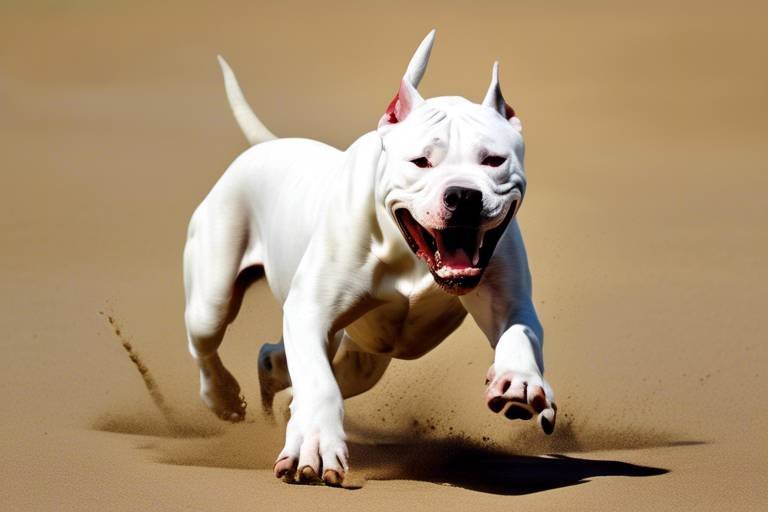Understanding the Different Types of Bulldogs
Bulldogs have captured the hearts of dog lovers around the world, and it's no wonder why! These adorable pups come with a variety of breeds, each boasting its own unique traits and quirks. From their charming personalities to their distinctive appearances, bulldogs are more than just pets; they are family members. In this comprehensive guide, we will explore the different types of bulldogs, highlighting their history, characteristics, and care requirements. Whether you're considering adding a bulldog to your family or simply want to learn more about these lovable canines, you've come to the right place!
First off, let's dive a little deeper into the history of bulldogs. Did you know that bulldogs originally were bred for bull-baiting? Yes, that's right! These dogs were once fierce competitors in a brutal sport. However, as society evolved, so did the purpose of these magnificent animals. They transformed from fierce fighters to gentle companions, known for their loyalty and affection. Understanding this transition helps us appreciate the gentle giants they are today.
Now, let's take a closer look at the most popular breeds within the bulldog family. Each breed has its own unique characteristics that set it apart from the others. For instance, the English Bulldog is perhaps the most recognizable, with its loose, wrinkled skin and pushed-in nose. It’s a breed that exudes charm and has a temperament that is surprisingly gentle despite its tough appearance. On the other hand, the French Bulldog has become a social media darling, known for its playful nature and compact size, making it a favorite among city dwellers. Lastly, the American Bulldog showcases strength and agility, often found in working roles, proving that bulldogs can be versatile companions.
As we explore the characteristics of each breed, we will also discuss their care requirements. Bulldogs, while generally low-maintenance, do have specific needs that must be met to ensure they lead happy and healthy lives. From grooming to exercise, understanding these requirements is crucial for any prospective bulldog owner.
So, whether you're a bulldog enthusiast or just curious about these wonderful dogs, stay tuned! We will uncover the rich history, unique traits, and essential care tips for each bulldog breed. By the end of this article, you’ll not only know which bulldog might be the best fit for your lifestyle but also appreciate the charm and character that each breed brings to the table. Let’s get started!

History of Bulldogs
The history of bulldogs is both rich and fascinating, stretching back to their origins as fierce bull-baiting dogs in medieval England. These dogs were bred for their strength and tenacity, originally serving a grim purpose as they were used to grab and hold onto bulls by the nose. This brutal sport was a popular pastime, and the bulldog was the star of the show, showcasing its bravery and resilience in the face of danger. However, as society evolved and animal welfare became a priority, bull-baiting was outlawed in the early 19th century, leading to a significant transformation in the bulldog's role in human life.
With the end of bull-baiting, the bulldog underwent a remarkable change. Breeders began to focus on cultivating a more gentle temperament, and the breed started to morph into the loving companions we know today. This transition was not just about temperament; it also involved a shift in physical traits. The once agile and muscular bulldog became more compact and stocky, with a distinctive pushed-in nose and loose skin, traits that are now synonymous with the English Bulldog.
Throughout the years, bulldogs have maintained their popularity, becoming symbols of loyalty and courage. They have been featured in various forms of media, from literature to film, and even as mascots for sports teams. The breed's unique appearance and gentle demeanor have made them beloved pets in households around the world. Today, bulldogs are celebrated not just for their history, but for their ability to adapt and thrive as family companions.
As we delve deeper into the different types of bulldogs, it’s essential to recognize how their historical roots have shaped their unique characteristics and behaviors. Here’s a quick overview of the significant milestones in bulldog history:
| Era | Significant Event |
|---|---|
| Medieval Period | Bulldogs used in bull-baiting |
| 19th Century | Outlawing of bull-baiting leads to breeding for gentler traits |
| 20th Century | Bulldogs become popular family pets and media icons |
Understanding the history of bulldogs not only enriches our appreciation of these incredible dogs but also provides insight into their care and training needs. As we move forward in this article, we will explore the different breeds of bulldogs, each with its own unique story and traits that make them special.
- What were bulldogs originally bred for? Bulldogs were originally bred for bull-baiting, a practice that involved attacking bulls.
- How have bulldogs changed over time? Bulldogs have transitioned from fierce fighters to gentle companions due to changes in breeding practices.
- Are bulldogs good family pets? Yes, bulldogs are known for their affectionate nature and make excellent family pets.

English Bulldog
The is perhaps the most recognizable breed among bulldogs, often seen as the poster dog for the entire group. With their loose, wrinkled skin and distinctive pushed-in nose, they are a breed that captures hearts at first glance. But what lies beneath that adorable exterior? Understanding the temperament, care needs, and history of the English Bulldog is essential for anyone considering adding one to their family. These dogs are not just a pretty face; they have a rich background and a personality that is both endearing and unique.
Historically, English Bulldogs were bred for bull-baiting, a cruel sport that involved dogs attacking a tethered bull. Thankfully, those days are long gone, and this breed has evolved into a gentle companion. Today, they are known for their calm demeanor and affectionate nature. Despite their intimidating appearance, English Bulldogs are often described as "gentle giants" who are incredibly loyal to their families. They thrive on human companionship and are known to be particularly good with children, making them an excellent choice for families.
When it comes to physical traits, English Bulldogs are truly one-of-a-kind. They have a stocky build, with a broad chest and sturdy legs that give them a powerful appearance. Their heads are large and square, with a short muzzle that adds to their distinctive look. Some key features include:
- Wrinkled Skin: The loose skin around their face and body is not just for show; it helps protect them during their historical roles in bull-baiting.
- Short Legs: Their short stature makes them look adorably clumsy, but it also contributes to their unique charm.
- Distinctive Gait: Bulldogs have a unique waddle that makes them instantly recognizable, and it’s part of what makes them so lovable.
These physical characteristics not only contribute to their charm but also require special care. For instance, their wrinkles need regular cleaning to prevent skin infections, and their short snouts can lead to breathing difficulties, especially in hot weather.
Now, let’s talk about personality. English Bulldogs are known for their laid-back attitude. They are not overly energetic, which makes them perfect for apartment living. However, don't let their calm nature fool you; they have a playful side that shines through during playtime. They enjoy short walks and play sessions but are equally content lounging on the couch with their favorite human. Their affectionate nature means they thrive on attention and love being part of family activities. They are also known for their stubbornness, which can make training a bit of a challenge, but with consistency and patience, they can learn commands and tricks.
In summary, the English Bulldog is a breed that combines unique physical traits with a gentle and loving temperament. They are perfect companions for those who appreciate their quirky charm and are willing to invest time in their care and training. With the right environment and love, they can become an irreplaceable part of your family.
Q: How much exercise does an English Bulldog need?
A: English Bulldogs require moderate exercise. Short daily walks and playtime are usually sufficient. They are not high-energy dogs, so don’t worry about long runs.
Q: Are English Bulldogs good with children?
A: Yes! They are known for being gentle and affectionate with children, making them great family pets.
Q: Do English Bulldogs have any health issues?
A: Yes, they can be prone to certain health issues, particularly related to their breathing and skin. Regular vet check-ups are essential to ensure their well-being.
Q: How often should I groom my English Bulldog?
A: Regular grooming is important, especially cleaning their wrinkles. A weekly brush can help keep their coat healthy.
Physical Characteristics
The English Bulldog boasts a truly unique appearance that sets it apart from other breeds. With a stocky, muscular build, they possess a low center of gravity, which gives them a solid and robust profile. Their weight typically ranges between 40 to 50 pounds, and their height is around 14 to 15 inches at the shoulder. One of the most striking features of the English Bulldog is its wrinkled face and pushed-in nose, which contribute to their endearing and somewhat comical expression. These facial wrinkles are not just for show; they are a hallmark of the breed that has evolved over centuries.
In terms of coat, English Bulldogs have a short, smooth, and shiny exterior that comes in a variety of colors, including brindle, white, fawn, and a mix of these hues. Their skin is loose, which adds to their charming appearance but also requires proper care to avoid skin issues. The folds of skin need to be cleaned regularly to prevent infections or irritations that can arise from moisture and debris accumulation. Just like you wouldn’t let a friend walk around with a messy shirt, your Bulldog deserves the same attention to cleanliness!
Another fascinating aspect of their physicality is their distinctive gait. When an English Bulldog walks, it often appears as if they’re waddling, a result of their broad chest and short legs. This unique movement only adds to their charm and makes them instantly recognizable. Their broad, square-shaped head is also a significant characteristic, often adorned with a strong jaw that gives them a fierce look, despite their generally gentle demeanor.
To summarize, here’s a quick overview of the English Bulldog's physical characteristics:
| Feature | Description |
|---|---|
| Weight | 40-50 pounds |
| Height | 14-15 inches |
| Coat | Short, smooth, shiny; colors include brindle, white, and fawn |
| Face | Wrinkled with a pushed-in nose |
| Body Type | Stocky and muscular |
Understanding these physical characteristics is essential not only for appreciating the breed but also for ensuring proper care. With their unique looks come specific needs that every owner should be aware of. So, if you’re considering bringing an English Bulldog into your home, get ready for a delightful companion that’s as charming as they are unique!
Temperament and Behavior
When it comes to the English Bulldog, their temperament is as unique as their appearance. Often described as gentle giants, these dogs possess a calm demeanor that makes them incredibly endearing. Despite their stocky build and tough exterior, they are known for their affectionate nature and loyalty to their families. You might be surprised to learn that they are not the aggressive breed some might assume; rather, they are loving companions who thrive on human interaction.
One of the most charming aspects of the English Bulldog's behavior is their playfulness. They enjoy engaging in light-hearted activities, but they also appreciate their downtime. Imagine them lounging on the couch, snoring softly while dreaming of chasing after a ball. Their laid-back attitude makes them suitable for various living situations, whether in a bustling family home or a cozy apartment. However, don't let their relaxed nature fool you; they do require regular exercise to maintain a healthy weight and keep their spirits high.
Socialization is key for English Bulldogs. Early exposure to different people, pets, and environments helps them develop into well-adjusted adults. They can be a bit stubborn, which means training should be approached with patience and consistency. Positive reinforcement works wonders with these dogs. Picture yourself rewarding them with treats and praise every time they follow a command—this not only encourages good behavior but also strengthens the bond between you and your furry friend.
Another important aspect of their temperament is their protective nature. English Bulldogs may not be the loudest watchdogs, but they are incredibly loyal and will alert you if something seems amiss. This instinct to protect their family makes them excellent companions for both individuals and families alike. They are known to be particularly good with children, often forming strong bonds and displaying a gentle demeanor around them. However, supervision is always recommended, especially with younger kids, to ensure that playtime remains safe and enjoyable for everyone involved.
In summary, the English Bulldog’s temperament is characterized by a blend of affection, playfulness, and loyalty. Their gentle nature and adaptability make them a favorite among dog lovers, while their unique personality traits ensure that life with an English Bulldog is never dull. If you're considering adding one of these lovable companions to your family, be prepared for a lifetime of joy, laughter, and unconditional love.
- Do English Bulldogs require a lot of exercise?
While they do need regular exercise to stay healthy, English Bulldogs are not overly active. Short walks and playtime are usually sufficient.
- Are English Bulldogs good with children?
Yes, they are known to be gentle and protective around children, making them great family pets.
- Do they have any specific health issues?
Yes, English Bulldogs can be prone to certain health problems, including breathing issues and joint problems, so regular vet check-ups are essential.
- How much grooming do they need?
English Bulldogs have short hair and require minimal grooming, but regular cleaning of their facial wrinkles is important to prevent infections.

French Bulldog
The has become a darling of dog lovers around the world, and it’s not hard to see why. With their adorable bat-like ears and charming personalities, these little companions bring joy to countless homes. Their compact size makes them ideal for city living, while their playful nature ensures that there’s never a dull moment. But what exactly makes the French Bulldog so special? Let’s dive into their unique characteristics and discover why they have captured the hearts of so many.
When you think of a French Bulldog, the first thing that probably comes to mind is their distinctive appearance. These dogs are characterized by their short snouts and large, expressive eyes that seem to say, "I’m ready for some fun!" Their muscular build and sturdy frame give them a robust look, but it’s their ears that truly set them apart. Unlike other breeds, French Bulldogs have bat ears that stand upright, giving them a unique and adorable silhouette. This combination of features not only makes them visually appealing but also adds to their playful and mischievous demeanor.
Caring for a French Bulldog requires a bit of special attention, primarily due to their unique health needs. These dogs are prone to certain health issues, especially related to their brachycephalic (short-nosed) structure. Owners should be aware of potential breathing difficulties, particularly in hot weather or during strenuous exercise. To ensure your Frenchie remains happy and healthy, consider the following care tips:
- Grooming: French Bulldogs have a short coat that requires minimal grooming, but regular brushing helps reduce shedding and keeps their skin healthy.
- Exercise: While they don’t need excessive exercise, regular short walks and playtime are essential to keep them fit and mentally stimulated.
- Health Check-ups: Routine vet visits are crucial to monitor for common health issues such as hip dysplasia and skin allergies.
By following these care requirements, you can help ensure that your French Bulldog lives a long and fulfilling life. Remember, regular check-ups and a balanced diet are key components of their overall health.
As with any beloved breed, potential owners often have questions about the French Bulldog. Here are some of the most frequently asked questions:
- Do French Bulldogs bark a lot? While they can be vocal, they are not known to be excessive barkers. They may bark to alert you or when they are playing.
- Are French Bulldogs good with children? Yes, they are generally very friendly and affectionate towards children, making them great family pets.
- What is the average lifespan of a French Bulldog? French Bulldogs typically live between 10 to 12 years, but with proper care, some can live even longer.
In conclusion, the French Bulldog is a breed that combines charm, playfulness, and companionship. Their unique features and specific care requirements make them a delightful addition to any home. Whether you’re considering adopting one or already have a Frenchie, understanding their needs and characteristics will help you foster a loving and healthy environment for your furry friend.
Distinctive Features
The French Bulldog is a breed that stands out in a crowd, not just for its playful personality but also for its adorable and unique physical traits. One of the most striking features of the Frenchie is its bat-like ears. These ears are not only cute but also serve a functional purpose, providing excellent hearing. It’s almost as if they were designed to catch every little sound around them, making them alert companions. Their short snouts give them a distinctive look, which adds to their charm. This physical characteristic, however, also means they can be prone to certain breathing issues, a fact that potential owners should keep in mind.
Another notable aspect of the French Bulldog's appearance is their compact and muscular build. These dogs are sturdy yet small, usually weighing between 16 to 28 pounds. Their stocky bodies are complemented by a smooth coat that comes in various colors, including brindle, fawn, and white. This diversity in coat color allows them to be a perfect match for different personalities and lifestyles. The combination of their unique features creates an irresistible package that has captured the hearts of many dog lovers around the world.
To give you a clearer picture of what makes the French Bulldog so distinctive, here’s a quick comparison of their features against other bulldog breeds:
| Feature | French Bulldog | English Bulldog | American Bulldog |
|---|---|---|---|
| Ears | Bat-like | Rose-shaped | Medium-sized |
| Snout | Short | Pushed-in | Moderate length |
| Size | Compact | Stout | Large and muscular |
| Weight | 16-28 lbs | 40-50 lbs | 60-120 lbs |
In addition to their physical traits, French Bulldogs also have a playful and affectionate demeanor. Their small size makes them perfect for apartment living, yet they are full of energy, ready to play at a moment's notice. They are known for their quirky personalities, often displaying a sense of humor that keeps their owners entertained. Whether they are chasing after a toy or snuggling up on the couch, French Bulldogs bring joy and laughter into any home.
In summary, the distinctive features of the French Bulldog—ranging from their unique ears and snouts to their compact build—make them a beloved breed among dog enthusiasts. Their playful nature, combined with their charming looks, ensures that they remain a popular choice for families and individuals alike. If you’re considering adding a Frenchie to your household, be prepared for a lifetime of love, laughter, and those adorable little quirks that make them so special!
- What should I feed my French Bulldog? A balanced diet with high-quality dog food appropriate for their age is essential.
- How much exercise do French Bulldogs need? They require moderate exercise, such as short walks and playtime, but should avoid strenuous activities due to their breathing issues.
- Are French Bulldogs good with children? Yes, they are generally gentle and affectionate, making them great companions for kids.
Care Requirements
Caring for a French Bulldog is not just about providing food and shelter; it’s about understanding their unique needs to ensure they lead happy, healthy lives. These adorable companions require special attention due to their distinct physical characteristics and health predispositions. First and foremost, grooming is a crucial aspect of their care. French Bulldogs have a short coat that is relatively easy to maintain, but they do shed, so regular brushing is recommended to minimize hair around your home. A gentle brush a couple of times a week can keep their coat looking sleek and shiny.
Another significant factor is their exercise routine. While they are not as high-energy as some breeds, French Bulldogs still need daily walks and playtime to keep them physically fit and mentally stimulated. Aim for at least 30 minutes of moderate exercise each day, which can include walks, playtime in the yard, or interactive games. However, be cautious during hot weather; Frenchies can be prone to overheating due to their brachycephalic (flat-faced) structure. Always ensure they have access to fresh water and a cool place to rest.
Nutrition is equally important in maintaining the health of your French Bulldog. A balanced diet tailored to their age, weight, and activity level will help prevent obesity, which is a common concern for this breed. Look for high-quality dog food that lists meat as the first ingredient, and avoid foods with excessive fillers. It's also wise to consult with your veterinarian to determine the best diet plan for your furry friend.
Moreover, regular vet check-ups are essential to monitor their health and catch any potential issues early. French Bulldogs can be prone to certain health conditions, such as hip dysplasia, skin allergies, and respiratory problems. Keeping up with vaccinations, dental care, and parasite prevention will go a long way in ensuring your pup stays healthy. In fact, having a routine health check can help you stay ahead of any issues, allowing for a longer and happier life for your beloved companion.
Lastly, socialization plays a vital role in a French Bulldog's development. Exposing them to different environments, people, and other animals at a young age can help them become well-adjusted adults. This breed is known for being friendly and sociable, so providing opportunities for them to interact with others can enhance their natural temperament.
In summary, caring for a French Bulldog involves a combination of grooming, exercise, nutrition, regular veterinary care, and socialization. By paying attention to these key areas, you can ensure that your Frenchie leads a fulfilling and joyful life by your side.
- How often should I groom my French Bulldog? Regular brushing a couple of times a week is recommended to manage shedding and keep their coat healthy.
- What type of diet is best for a French Bulldog? A high-quality dog food with meat as the first ingredient is ideal, tailored to their age and activity level.
- How much exercise do French Bulldogs need? Aim for at least 30 minutes of moderate exercise daily, keeping in mind their sensitivity to heat.
- Are French Bulldogs prone to any health issues? Yes, they can be prone to respiratory issues, hip dysplasia, and skin allergies, making regular vet visits important.
- What is the best way to socialize my French Bulldog? Expose them to various environments, people, and other pets from a young age to help them become well-adjusted.

American Bulldog
The is a breed that embodies strength, agility, and loyalty. Originally bred for farm work and protection, these dogs are not just muscular; they also possess a gentle heart that makes them wonderful companions. Their robust build and energetic nature make them suitable for a variety of roles, from family pets to working dogs. But what truly sets the American Bulldog apart is its unique blend of tenacity and affection, making them a favorite among those who appreciate a dog with both brawn and brains.
When it comes to their physical appearance, American Bulldogs are known for their powerful stance and athletic build. Typically, they have a broad head, strong jaws, and a short coat that can come in various colors, including white, brindle, and fawn. Their muscular frame not only gives them a commanding presence but also allows them to excel in various activities, whether it’s agility training or simply keeping up with the kids in the backyard.
Training an American Bulldog can be both rewarding and challenging. These dogs are intelligent and eager to please, but they also have a stubborn streak that can test your patience. Consistency is key when it comes to training. Positive reinforcement techniques, such as treats and praise, work wonders in encouraging good behavior. It's essential to start training early and to incorporate socialization to help them become well-rounded pets. Exposing your American Bulldog to different environments, people, and other animals will help them develop confidence and reduce the likelihood of behavioral issues.
Here are some effective training tips:
- Start Early: Begin training as soon as you bring your American Bulldog home.
- Be Consistent: Use the same commands and rewards to reinforce behavior.
- Socialize: Introduce your dog to various situations to help them adapt.
- Keep Sessions Short: Dogs have short attention spans, so keep training sessions brief but frequent.
Like all breeds, American Bulldogs come with their own set of health considerations. While they are generally robust dogs, they can be prone to certain health issues that potential owners should be aware of. Common concerns include hip dysplasia, skin allergies, and certain heart conditions. Regular veterinary check-ups, a balanced diet, and exercise are crucial in maintaining their health. Additionally, being aware of their physical limitations, especially in hot weather, is essential to ensure their well-being.
To keep your American Bulldog in tip-top shape, consider the following health maintenance tips:
- Regular Vet Visits: Schedule annual check-ups to catch potential issues early.
- Healthy Diet: Provide a balanced diet tailored to their age, weight, and activity level.
- Regular Exercise: Engage in daily physical activities to keep them fit and happy.
In conclusion, the American Bulldog is a breed that requires commitment, but the rewards are immeasurable. With their loving nature and protective instincts, they make excellent family companions. Whether you’re looking for a playmate for your children or a loyal friend to accompany you on outdoor adventures, the American Bulldog is sure to impress with its strength, intelligence, and affectionate demeanor.
Q: Are American Bulldogs good with children?
A: Yes! American Bulldogs are known for their gentle and protective nature, making them great companions for children when properly socialized.
Q: How much exercise do American Bulldogs need?
A: They require regular exercise, ideally 60 minutes a day, to keep them physically and mentally stimulated.
Q: Do American Bulldogs have any specific health issues?
A: Common health concerns include hip dysplasia and skin allergies, so regular vet check-ups are important.
Q: Are American Bulldogs easy to train?
A: They can be trained effectively with consistency and positive reinforcement, but they may exhibit a stubborn streak.
Training and Socialization
Training an American Bulldog is not just about teaching commands; it's about building a strong bond and understanding between you and your furry friend. These dogs are incredibly intelligent and eager to please, but they also possess a stubborn streak that can challenge even the most patient of owners. To effectively train your American Bulldog, consistency is key. Establishing a routine helps them understand what is expected, and positive reinforcement techniques work wonders. Imagine teaching your dog to sit by rewarding them with a treat every time they do it right; it’s like giving them a little high-five for their efforts!
Socialization is another vital aspect of raising a well-rounded American Bulldog. Early exposure to various environments, people, and other animals can significantly influence their behavior as they grow. Think of socialization as a crash course in doggy etiquette. By introducing your bulldog to different experiences, you are helping them develop confidence and reducing the chances of fear-based reactions later in life. For instance, taking them to a dog park can be a great way to meet other dogs and learn how to interact appropriately.
Here are some essential tips for effective training and socialization:
- Start Early: The earlier you begin training and socializing your American Bulldog, the better. Puppies are like sponges, soaking up new experiences and lessons.
- Be Consistent: Use the same commands and rewards consistently. Mixed signals can confuse your dog and hinder their learning process.
- Use Positive Reinforcement: Reward good behavior with treats, praise, or playtime. This approach encourages them to repeat the behavior.
- Expose Them to New Situations: Regularly introduce your bulldog to different people, environments, and other animals to enhance their social skills.
- Attend Training Classes: Consider enrolling in obedience classes. Professional trainers can provide valuable guidance and support.
Remember, the goal of training and socialization is not just to have a well-behaved dog, but to create a happy and confident companion who can thrive in various situations. Investing time and effort into training your American Bulldog will pay off in the long run, leading to a fulfilling relationship filled with joy and understanding.
Q: How long should I train my American Bulldog each day?
A: Short, consistent training sessions of about 10-15 minutes, two to three times a day, are often most effective. This keeps their attention and prevents boredom.
Q: Can I train my American Bulldog on my own?
A: Yes, many owners successfully train their dogs at home. However, seeking professional help can be beneficial, especially for first-time dog owners.
Q: What are some common behavioral issues in American Bulldogs?
A: Common issues include stubbornness, jumping, and chewing. Early training and socialization can help mitigate these behaviors.
Q: How important is socialization for American Bulldogs?
A: Extremely important! Proper socialization helps prevent fear and aggression, making your bulldog a more well-adjusted pet.
Health Considerations
The American Bulldog is a robust breed, but like all dogs, they come with their own set of health considerations that potential owners should be aware of. These dogs are known for their strength and agility, but this can also lead to certain health issues if not properly managed. One of the most common concerns is their susceptibility to hip dysplasia, a genetic condition where the hip joint doesn't fit into the hip socket properly. This can lead to arthritis and chronic pain, making it essential for owners to monitor their dog's weight and ensure they maintain a healthy lifestyle.
Another health issue that American Bulldogs may face is skin allergies. These can arise due to environmental factors or food sensitivities. Regular grooming and a proper diet can help mitigate these problems. It's also important to keep an eye on their eyes and ears, as Bulldogs can be prone to infections in these areas. Routine vet check-ups can help catch any potential issues early on.
Additionally, American Bulldogs are known to have a higher risk of certain cardiac problems. Conditions like dilated cardiomyopathy can affect their heart function, so staying informed about their heart health is crucial. Regular exercise is not only good for their physical health but also plays a role in maintaining their cardiovascular system. Owners should engage their dogs in daily activities that challenge them physically and mentally.
To summarize, here are some key health considerations for American Bulldogs:
- Hip Dysplasia: Watch for signs of pain and limit strenuous activity.
- Skin Allergies: Regular grooming and a balanced diet can help.
- Eye and Ear Infections: Regular check-ups are essential.
- Cardiac Issues: Ensure proper exercise and monitor heart health.
By being proactive about these health considerations, you can help ensure that your American Bulldog lives a long, happy, and healthy life. Remember, a well-informed owner is the best advocate for their pet's health!
Here are some common questions regarding the health of American Bulldogs:
- What are the signs of hip dysplasia in American Bulldogs? Look for limping, difficulty getting up, and reluctance to exercise.
- How can I prevent skin allergies in my Bulldog? Regular baths with hypoallergenic shampoo and a balanced diet can help reduce flare-ups.
- How often should I take my American Bulldog to the vet? Ideally, once a year for a check-up, but consult your vet for specific needs.
- What is the best diet for American Bulldogs? A high-quality, balanced diet tailored to their age and activity level is recommended.
Frequently Asked Questions
- What are the main types of bulldogs?
The main types of bulldogs include the English Bulldog, French Bulldog, and American Bulldog. Each breed has its own unique characteristics, history, and personality traits that make them special companions.
- How did bulldogs originate?
Bulldogs originated in England, where they were used for bull-baiting. This brutal sport eventually led to their evolution into the gentle and affectionate pets we know today. Their history is a fascinating journey from fierce fighters to beloved family members.
- What are the key traits of an English Bulldog?
English Bulldogs are known for their distinctive wrinkled faces, stout build, and gentle temperament. They are typically very affectionate, making them great companions for families and individuals alike.
- Are French Bulldogs good with kids?
Yes! French Bulldogs are playful and friendly, making them excellent companions for children. Their compact size and affectionate nature allow them to bond well with kids, although supervision is always recommended to ensure safe play.
- What special care do French Bulldogs require?
French Bulldogs need regular grooming, exercise, and attention to their health due to their brachycephalic (short-nosed) structure. It's essential to monitor their breathing and avoid strenuous activities in hot weather to keep them healthy.
- How strong are American Bulldogs?
American Bulldogs are known for their strength and agility. They are often used in working roles due to their physical capabilities, but they also make loyal and loving family pets with proper training and socialization.
- What training methods work best for American Bulldogs?
Consistent and positive reinforcement training methods work best for American Bulldogs. Early socialization and obedience training are crucial to help them become well-rounded and well-behaved pets.
- What health issues should I be aware of with bulldogs?
Bulldogs, like all breeds, can be prone to specific health issues. Common concerns include hip dysplasia, skin problems, and respiratory issues, especially in brachycephalic breeds like the French Bulldog. Regular vet check-ups and a healthy lifestyle can help mitigate these risks.

